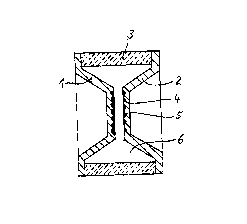Une partie des informations de ce site Web a été fournie par des sources externes. Le gouvernement du Canada n'assume aucune responsabilité concernant la précision, l'actualité ou la fiabilité des informations fournies par les sources externes. Les utilisateurs qui désirent employer cette information devraient consulter directement la source des informations. Le contenu fourni par les sources externes n'est pas assujetti aux exigences sur les langues officielles, la protection des renseignements personnels et l'accessibilité.
L'apparition de différences dans le texte et l'image des Revendications et de l'Abrégé dépend du moment auquel le document est publié. Les textes des Revendications et de l'Abrégé sont affichés :
| (12) Demande de brevet: | (11) CA 2306518 |
|---|---|
| (54) Titre français: | PROTECTEUR ANTI-SURTENSION A GAZ ACTIONNE PAR UN MELANGE D'UNE PLURALITE DE COMPOSANTS |
| (54) Titre anglais: | GAS-FILLED SURGE ARRESTER WITH AN ACTIVATING COMPOUND FORMED OF A PLURALITY OF COMPONENTS |
| Statut: | Réputée abandonnée et au-delà du délai pour le rétablissement - en attente de la réponse à l’avis de communication rejetée |
| (51) Classification internationale des brevets (CIB): |
|
|---|---|
| (72) Inventeurs : |
|
| (73) Titulaires : |
|
| (71) Demandeurs : |
|
| (74) Agent: | SMART & BIGGAR LP |
| (74) Co-agent: | |
| (45) Délivré: | |
| (22) Date de dépôt: | 2000-04-25 |
| (41) Mise à la disponibilité du public: | 2000-10-23 |
| Requête d'examen: | 2000-10-18 |
| Licence disponible: | S.O. |
| Cédé au domaine public: | S.O. |
| (25) Langue des documents déposés: | Anglais |
| Traité de coopération en matière de brevets (PCT): | Non |
|---|
| (30) Données de priorité de la demande: | ||||||
|---|---|---|---|---|---|---|
|
A gas-filled surge arrester includes at least two
electrodes, a hydrogen-containing gas filling and an activating
compound applied to at least one of the electrodes. In order
to ensure the required operating behavior of the surge arrester
even at temperatures of up to 40 °C, the activating compound
contains nickel powder and potassium silicate as basic
components each in amounts of 25 to 30% by weight, sodium
bromide in an amount of 15 to 20% by weight, as well as
aluminum powder, sodium silicate and barium titanate as further
components each in an amount of 5 to 10% by weight.
Note : Les revendications sont présentées dans la langue officielle dans laquelle elles ont été soumises.
Note : Les descriptions sont présentées dans la langue officielle dans laquelle elles ont été soumises.

2024-08-01 : Dans le cadre de la transition vers les Brevets de nouvelle génération (BNG), la base de données sur les brevets canadiens (BDBC) contient désormais un Historique d'événement plus détaillé, qui reproduit le Journal des événements de notre nouvelle solution interne.
Veuillez noter que les événements débutant par « Inactive : » se réfèrent à des événements qui ne sont plus utilisés dans notre nouvelle solution interne.
Pour une meilleure compréhension de l'état de la demande ou brevet qui figure sur cette page, la rubrique Mise en garde , et les descriptions de Brevet , Historique d'événement , Taxes périodiques et Historique des paiements devraient être consultées.
| Description | Date |
|---|---|
| Inactive : CIB de MCD | 2006-03-12 |
| Demande non rétablie avant l'échéance | 2004-04-26 |
| Le délai pour l'annulation est expiré | 2004-04-26 |
| Réputée abandonnée - omission de répondre à un avis sur les taxes pour le maintien en état | 2003-04-25 |
| Lettre envoyée | 2000-11-17 |
| Demande publiée (accessible au public) | 2000-10-23 |
| Inactive : Page couverture publiée | 2000-10-22 |
| Requête d'examen reçue | 2000-10-18 |
| Toutes les exigences pour l'examen - jugée conforme | 2000-10-18 |
| Exigences pour une requête d'examen - jugée conforme | 2000-10-18 |
| Lettre envoyée | 2000-10-13 |
| Inactive : Transfert individuel | 2000-09-14 |
| Modification reçue - modification volontaire | 2000-08-28 |
| Inactive : Correspondance - Formalités | 2000-07-24 |
| Inactive : CIB en 1re position | 2000-06-23 |
| Inactive : CIB attribuée | 2000-06-23 |
| Inactive : CIB attribuée | 2000-06-21 |
| Inactive : Certificat de dépôt - Sans RE (Anglais) | 2000-06-01 |
| Demande reçue - nationale ordinaire | 2000-05-31 |
| Date d'abandonnement | Raison | Date de rétablissement |
|---|---|---|
| 2003-04-25 |
Le dernier paiement a été reçu le 2002-04-03
Avis : Si le paiement en totalité n'a pas été reçu au plus tard à la date indiquée, une taxe supplémentaire peut être imposée, soit une des taxes suivantes :
Les taxes sur les brevets sont ajustées au 1er janvier de chaque année. Les montants ci-dessus sont les montants actuels s'ils sont reçus au plus tard le 31 décembre de l'année en cours.
Veuillez vous référer à la page web des
taxes sur les brevets
de l'OPIC pour voir tous les montants actuels des taxes.
| Type de taxes | Anniversaire | Échéance | Date payée |
|---|---|---|---|
| Taxe pour le dépôt - générale | 2000-04-25 | ||
| Enregistrement d'un document | 2000-09-14 | ||
| Requête d'examen - générale | 2000-10-18 | ||
| TM (demande, 2e anniv.) - générale | 02 | 2002-04-25 | 2002-04-03 |
Les titulaires actuels et antérieures au dossier sont affichés en ordre alphabétique.
| Titulaires actuels au dossier |
|---|
| EPCOS AG |
| Titulaires antérieures au dossier |
|---|
| JURGEN BOY |
| PETER BOBERT |
| WINFRIED VOLKNER |